Dynamic Modelling, Screen Design and Test Plans Assignment 2022
VerifiedAdded on 2022/10/07
|15
|1645
|19
Assignment
AI Summary
Contribute Materials
Your contribution can guide someone’s learning journey. Share your
documents today.
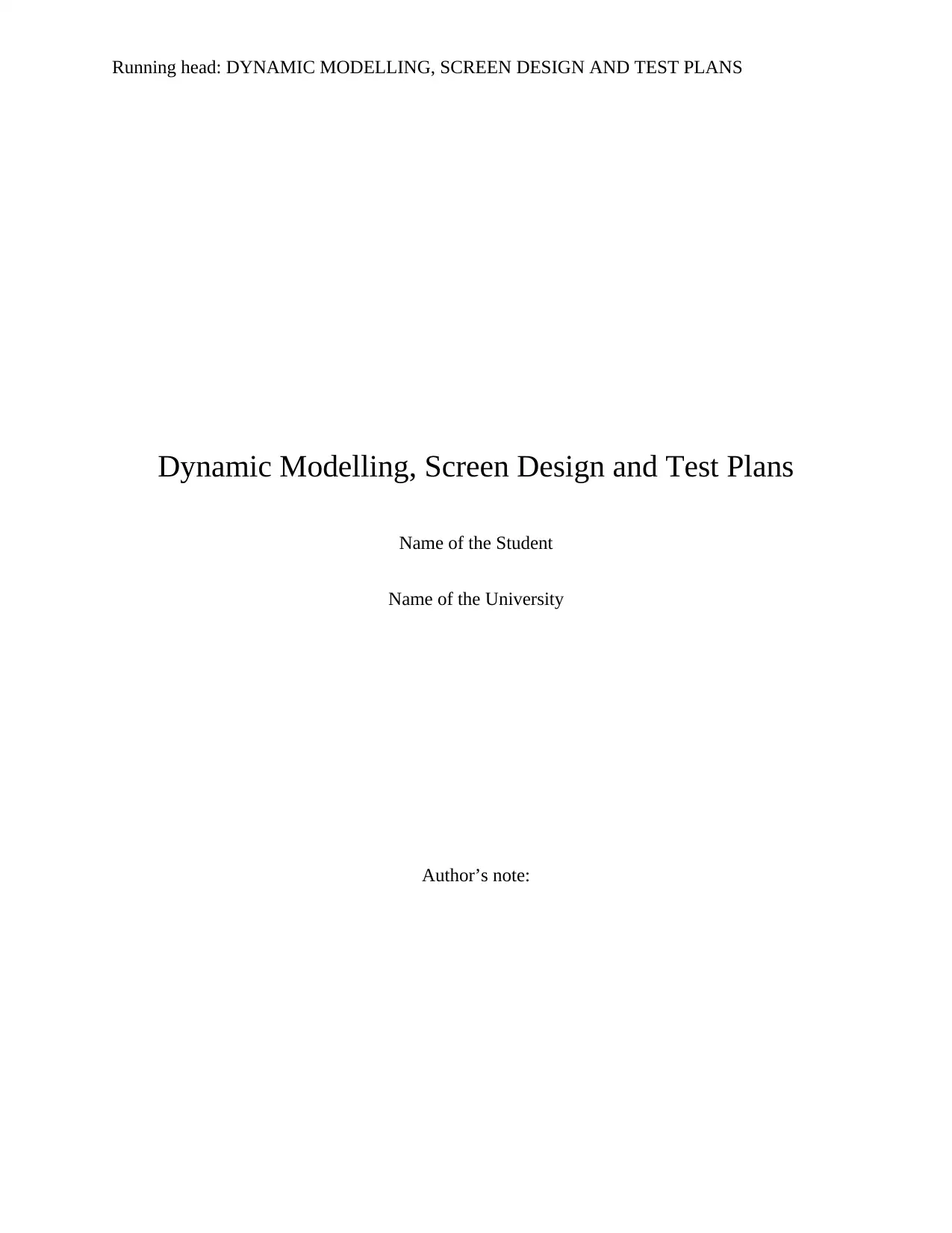
Running head: DYNAMIC MODELLING, SCREEN DESIGN AND TEST PLANS
Dynamic Modelling, Screen Design and Test Plans
Name of the Student
Name of the University
Author’s note:
Dynamic Modelling, Screen Design and Test Plans
Name of the Student
Name of the University
Author’s note:
Secure Best Marks with AI Grader
Need help grading? Try our AI Grader for instant feedback on your assignments.
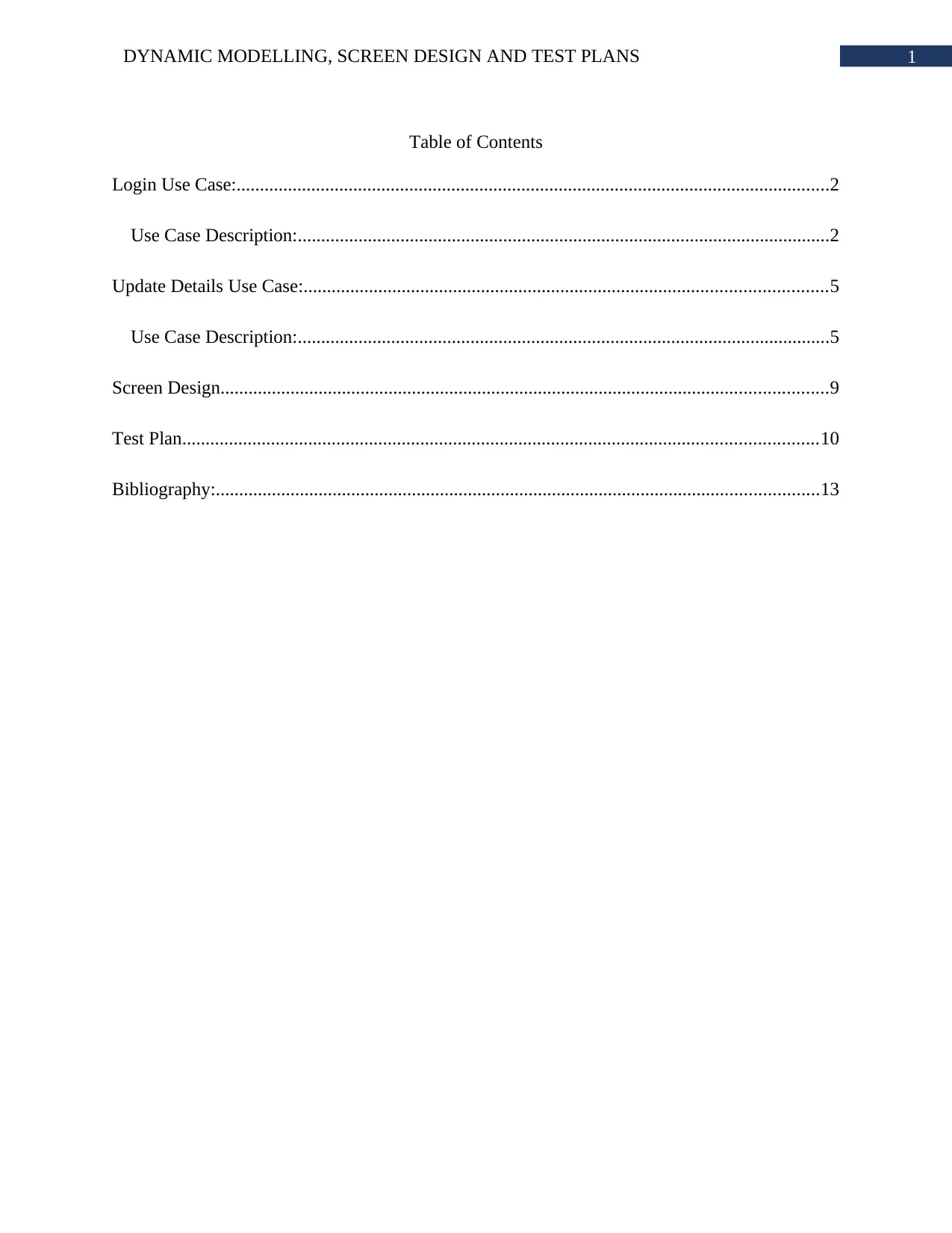
1DYNAMIC MODELLING, SCREEN DESIGN AND TEST PLANS
Table of Contents
Login Use Case:...............................................................................................................................2
Use Case Description:..................................................................................................................2
Update Details Use Case:................................................................................................................5
Use Case Description:..................................................................................................................5
Screen Design..................................................................................................................................9
Test Plan........................................................................................................................................10
Bibliography:.................................................................................................................................13
Table of Contents
Login Use Case:...............................................................................................................................2
Use Case Description:..................................................................................................................2
Update Details Use Case:................................................................................................................5
Use Case Description:..................................................................................................................5
Screen Design..................................................................................................................................9
Test Plan........................................................................................................................................10
Bibliography:.................................................................................................................................13
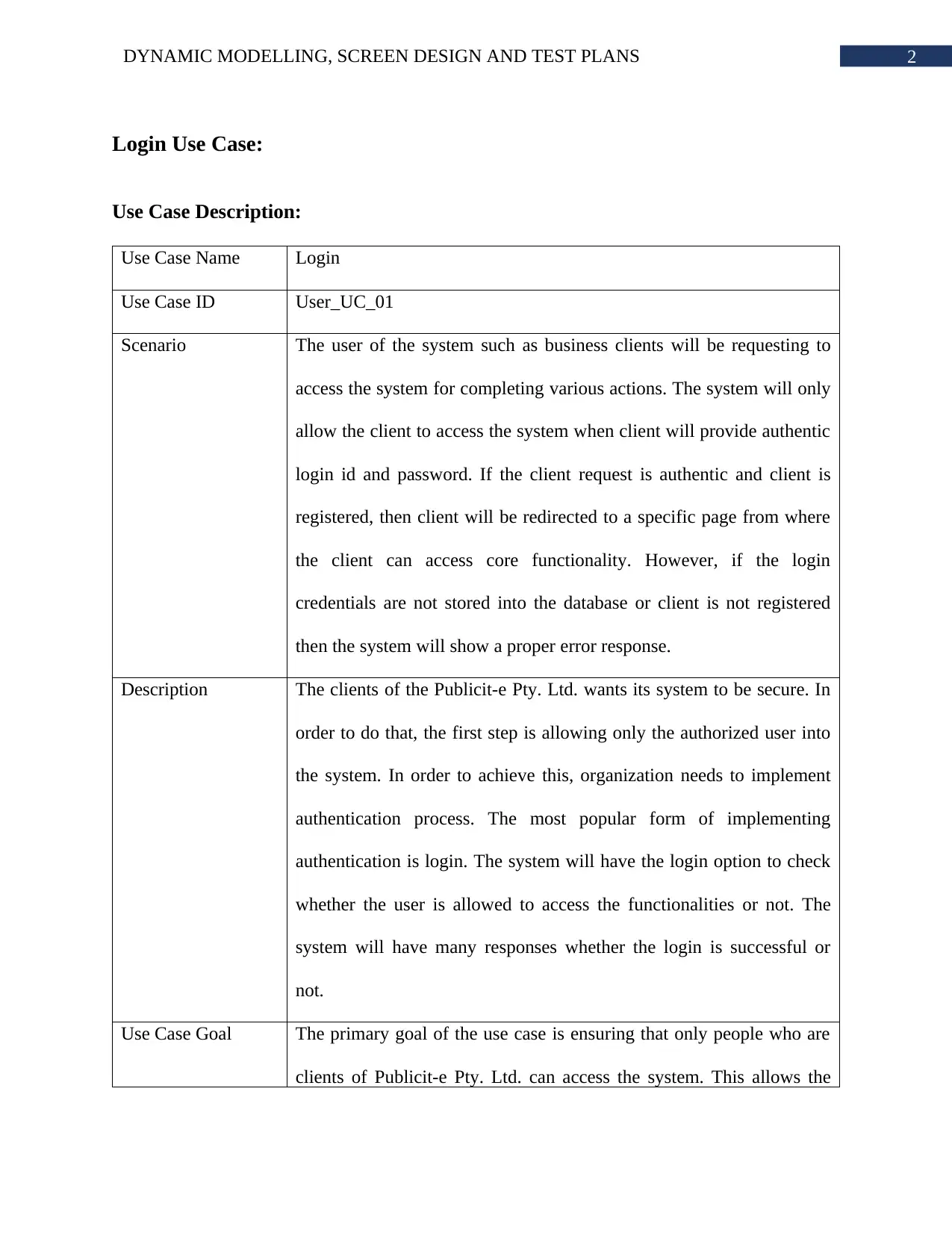
2DYNAMIC MODELLING, SCREEN DESIGN AND TEST PLANS
Login Use Case:
Use Case Description:
Use Case Name Login
Use Case ID User_UC_01
Scenario The user of the system such as business clients will be requesting to
access the system for completing various actions. The system will only
allow the client to access the system when client will provide authentic
login id and password. If the client request is authentic and client is
registered, then client will be redirected to a specific page from where
the client can access core functionality. However, if the login
credentials are not stored into the database or client is not registered
then the system will show a proper error response.
Description The clients of the Publicit-e Pty. Ltd. wants its system to be secure. In
order to do that, the first step is allowing only the authorized user into
the system. In order to achieve this, organization needs to implement
authentication process. The most popular form of implementing
authentication is login. The system will have the login option to check
whether the user is allowed to access the functionalities or not. The
system will have many responses whether the login is successful or
not.
Use Case Goal The primary goal of the use case is ensuring that only people who are
clients of Publicit-e Pty. Ltd. can access the system. This allows the
Login Use Case:
Use Case Description:
Use Case Name Login
Use Case ID User_UC_01
Scenario The user of the system such as business clients will be requesting to
access the system for completing various actions. The system will only
allow the client to access the system when client will provide authentic
login id and password. If the client request is authentic and client is
registered, then client will be redirected to a specific page from where
the client can access core functionality. However, if the login
credentials are not stored into the database or client is not registered
then the system will show a proper error response.
Description The clients of the Publicit-e Pty. Ltd. wants its system to be secure. In
order to do that, the first step is allowing only the authorized user into
the system. In order to achieve this, organization needs to implement
authentication process. The most popular form of implementing
authentication is login. The system will have the login option to check
whether the user is allowed to access the functionalities or not. The
system will have many responses whether the login is successful or
not.
Use Case Goal The primary goal of the use case is ensuring that only people who are
clients of Publicit-e Pty. Ltd. can access the system. This allows the
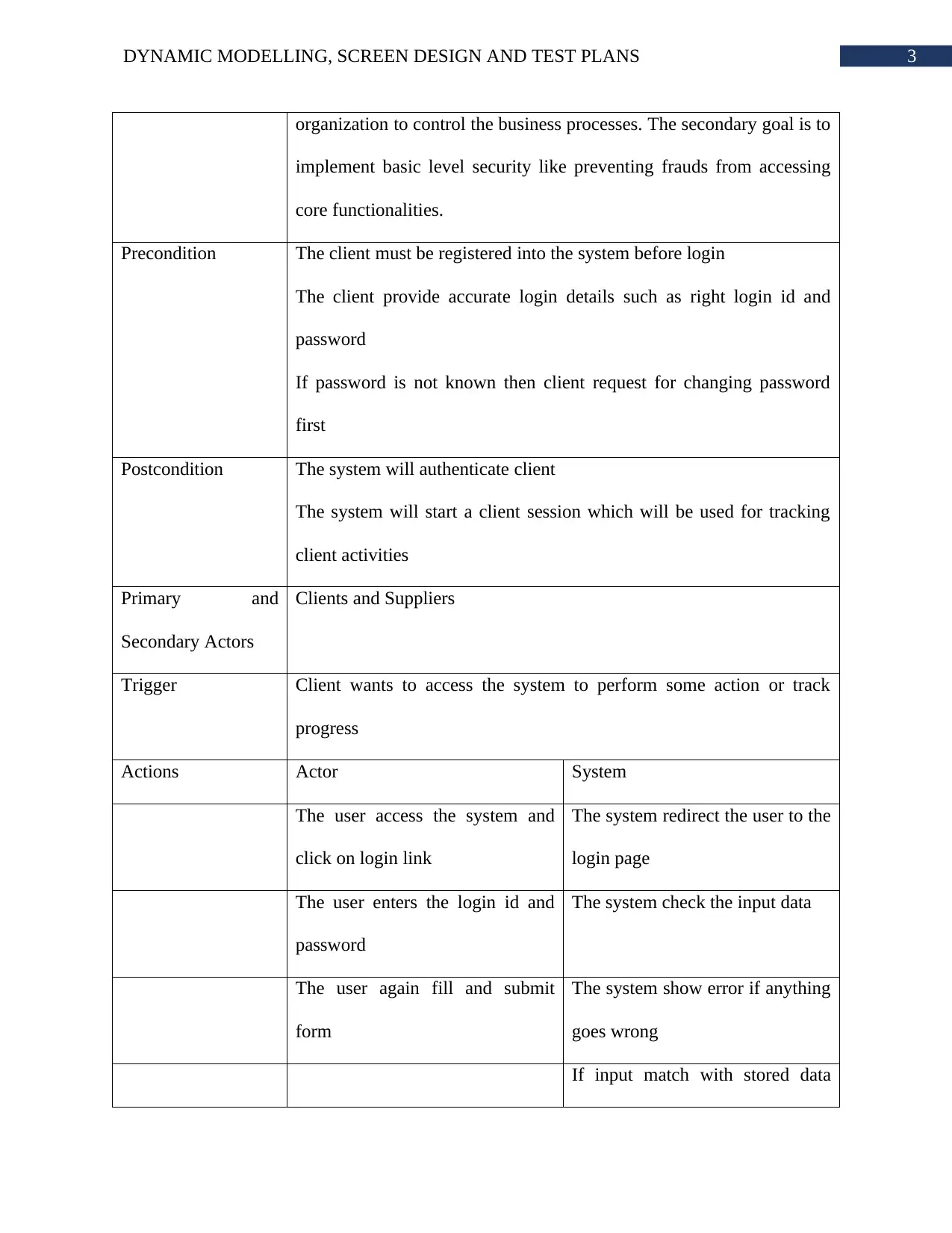
3DYNAMIC MODELLING, SCREEN DESIGN AND TEST PLANS
organization to control the business processes. The secondary goal is to
implement basic level security like preventing frauds from accessing
core functionalities.
Precondition The client must be registered into the system before login
The client provide accurate login details such as right login id and
password
If password is not known then client request for changing password
first
Postcondition The system will authenticate client
The system will start a client session which will be used for tracking
client activities
Primary and
Secondary Actors
Clients and Suppliers
Trigger Client wants to access the system to perform some action or track
progress
Actions Actor System
The user access the system and
click on login link
The system redirect the user to the
login page
The user enters the login id and
password
The system check the input data
The user again fill and submit
form
The system show error if anything
goes wrong
If input match with stored data
organization to control the business processes. The secondary goal is to
implement basic level security like preventing frauds from accessing
core functionalities.
Precondition The client must be registered into the system before login
The client provide accurate login details such as right login id and
password
If password is not known then client request for changing password
first
Postcondition The system will authenticate client
The system will start a client session which will be used for tracking
client activities
Primary and
Secondary Actors
Clients and Suppliers
Trigger Client wants to access the system to perform some action or track
progress
Actions Actor System
The user access the system and
click on login link
The system redirect the user to the
login page
The user enters the login id and
password
The system check the input data
The user again fill and submit
form
The system show error if anything
goes wrong
If input match with stored data
Secure Best Marks with AI Grader
Need help grading? Try our AI Grader for instant feedback on your assignments.
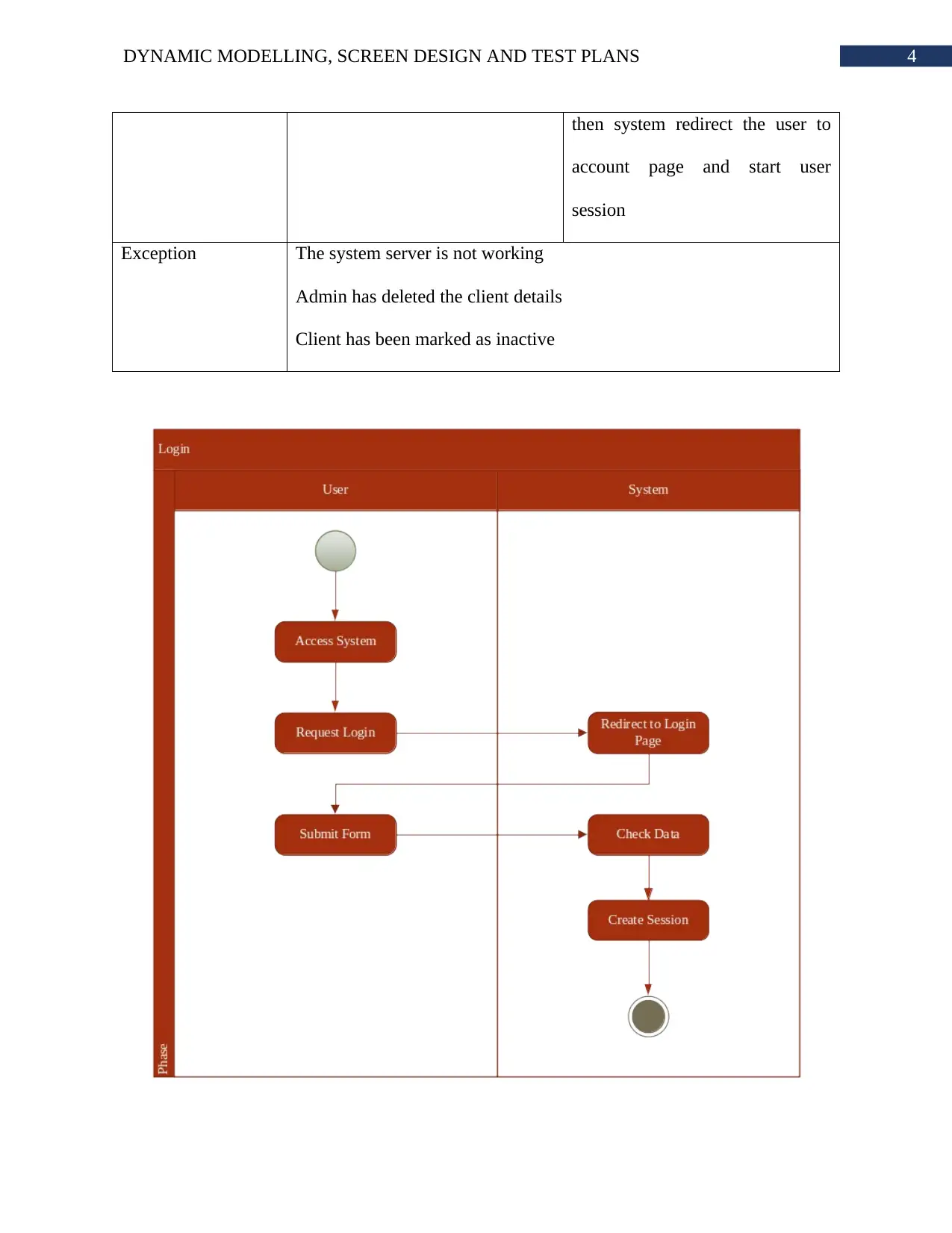
4DYNAMIC MODELLING, SCREEN DESIGN AND TEST PLANS
then system redirect the user to
account page and start user
session
Exception The system server is not working
Admin has deleted the client details
Client has been marked as inactive
then system redirect the user to
account page and start user
session
Exception The system server is not working
Admin has deleted the client details
Client has been marked as inactive
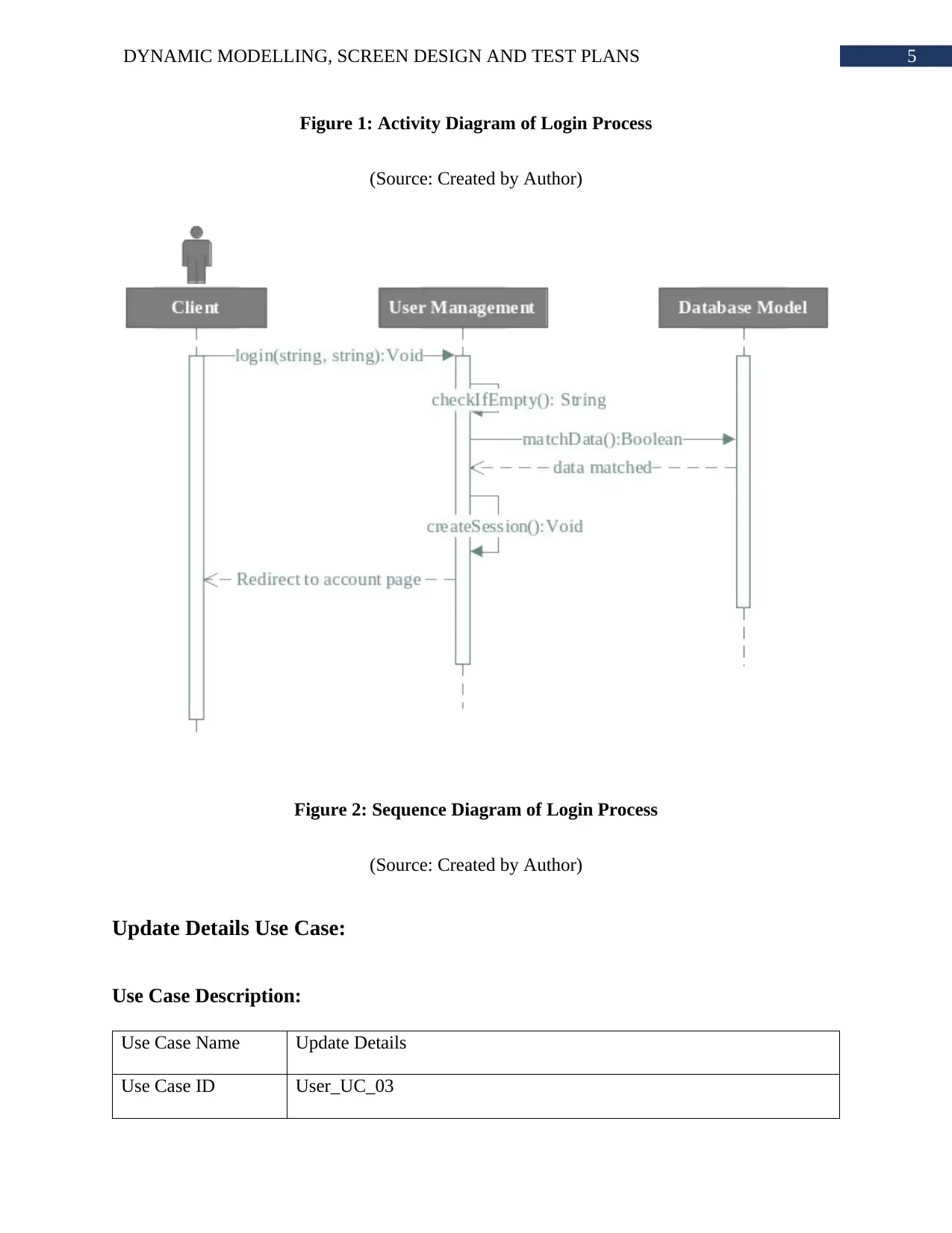
5DYNAMIC MODELLING, SCREEN DESIGN AND TEST PLANS
Figure 1: Activity Diagram of Login Process
(Source: Created by Author)
Figure 2: Sequence Diagram of Login Process
(Source: Created by Author)
Update Details Use Case:
Use Case Description:
Use Case Name Update Details
Use Case ID User_UC_03
Figure 1: Activity Diagram of Login Process
(Source: Created by Author)
Figure 2: Sequence Diagram of Login Process
(Source: Created by Author)
Update Details Use Case:
Use Case Description:
Use Case Name Update Details
Use Case ID User_UC_03
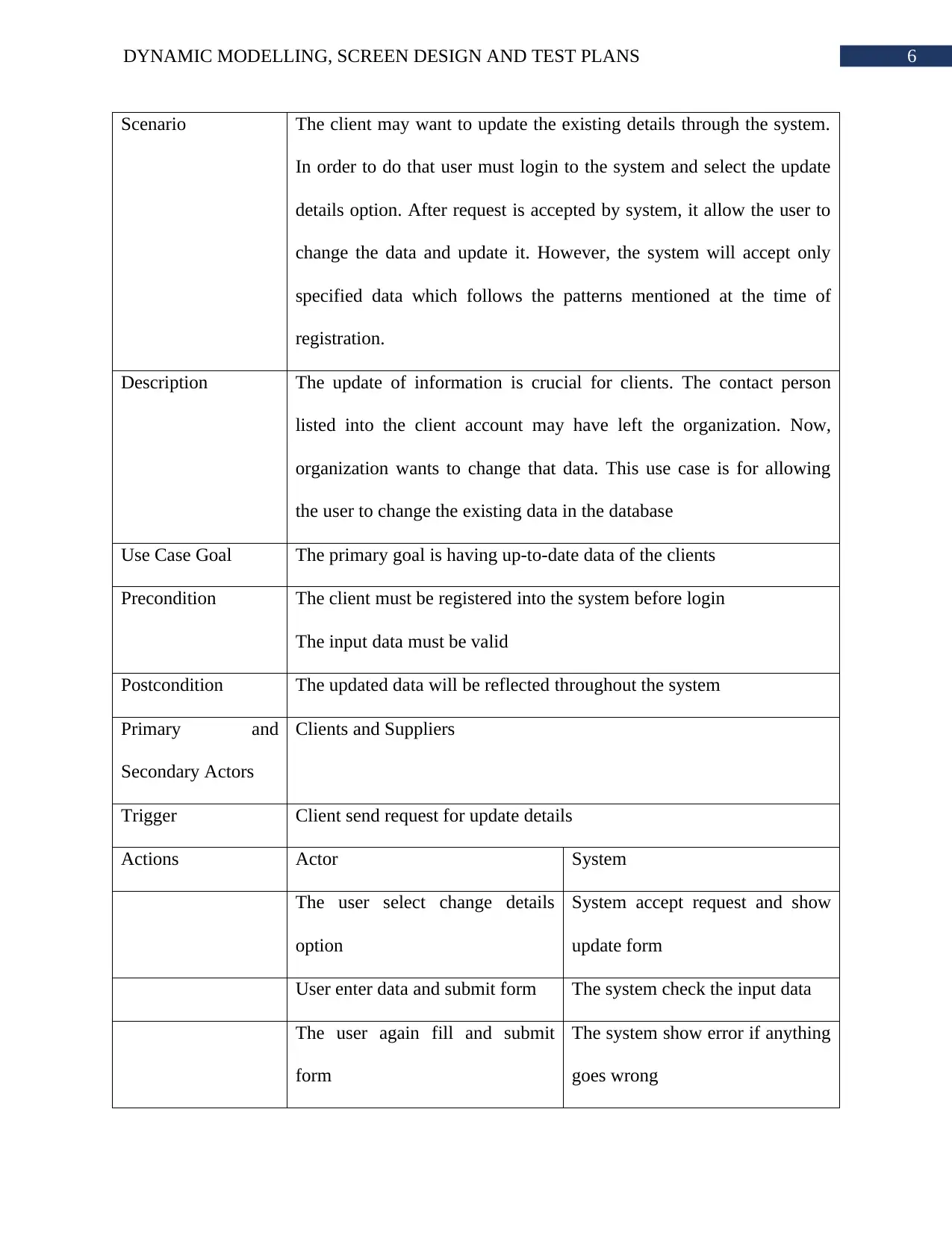
6DYNAMIC MODELLING, SCREEN DESIGN AND TEST PLANS
Scenario The client may want to update the existing details through the system.
In order to do that user must login to the system and select the update
details option. After request is accepted by system, it allow the user to
change the data and update it. However, the system will accept only
specified data which follows the patterns mentioned at the time of
registration.
Description The update of information is crucial for clients. The contact person
listed into the client account may have left the organization. Now,
organization wants to change that data. This use case is for allowing
the user to change the existing data in the database
Use Case Goal The primary goal is having up-to-date data of the clients
Precondition The client must be registered into the system before login
The input data must be valid
Postcondition The updated data will be reflected throughout the system
Primary and
Secondary Actors
Clients and Suppliers
Trigger Client send request for update details
Actions Actor System
The user select change details
option
System accept request and show
update form
User enter data and submit form The system check the input data
The user again fill and submit
form
The system show error if anything
goes wrong
Scenario The client may want to update the existing details through the system.
In order to do that user must login to the system and select the update
details option. After request is accepted by system, it allow the user to
change the data and update it. However, the system will accept only
specified data which follows the patterns mentioned at the time of
registration.
Description The update of information is crucial for clients. The contact person
listed into the client account may have left the organization. Now,
organization wants to change that data. This use case is for allowing
the user to change the existing data in the database
Use Case Goal The primary goal is having up-to-date data of the clients
Precondition The client must be registered into the system before login
The input data must be valid
Postcondition The updated data will be reflected throughout the system
Primary and
Secondary Actors
Clients and Suppliers
Trigger Client send request for update details
Actions Actor System
The user select change details
option
System accept request and show
update form
User enter data and submit form The system check the input data
The user again fill and submit
form
The system show error if anything
goes wrong
Paraphrase This Document
Need a fresh take? Get an instant paraphrase of this document with our AI Paraphraser
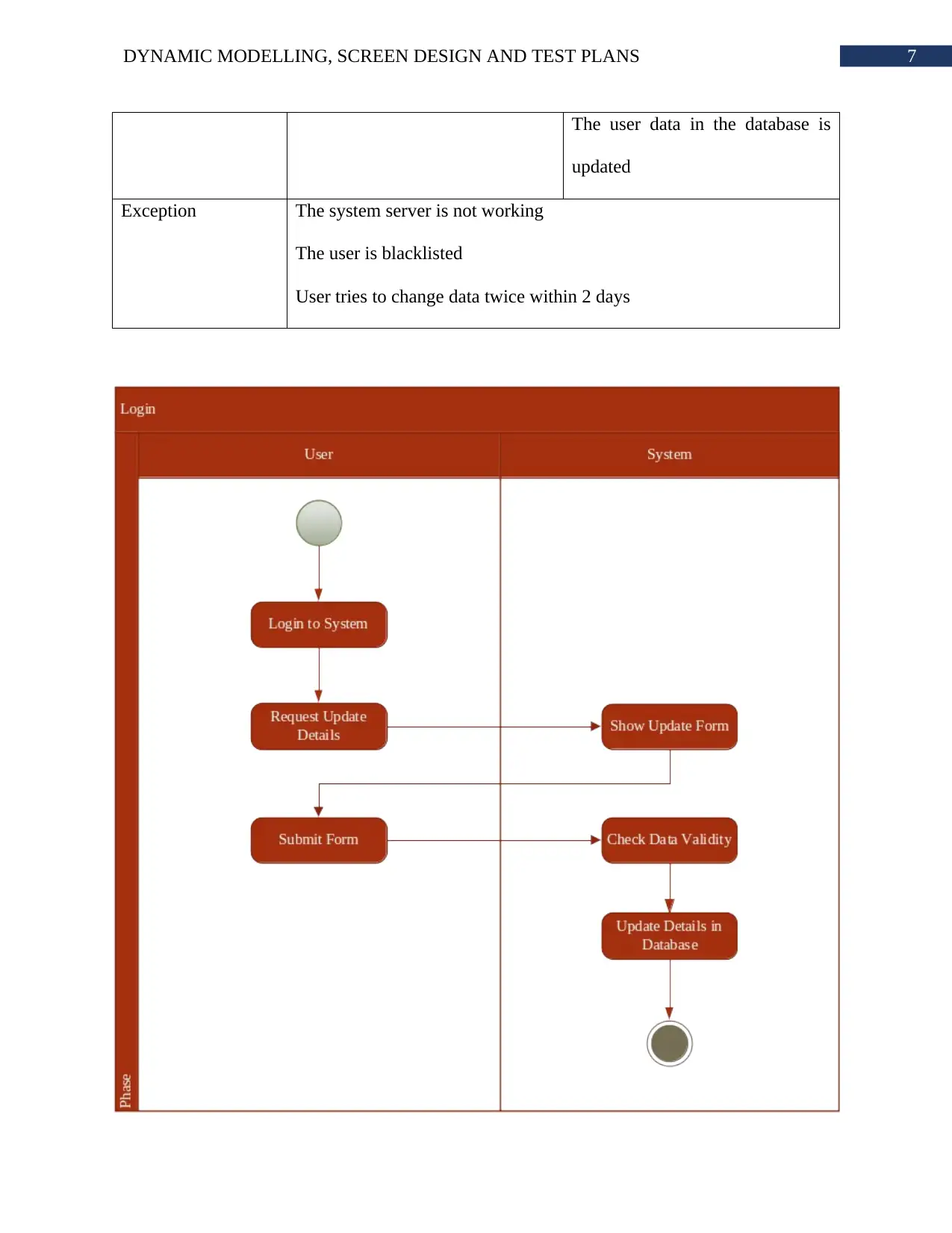
7DYNAMIC MODELLING, SCREEN DESIGN AND TEST PLANS
The user data in the database is
updated
Exception The system server is not working
The user is blacklisted
User tries to change data twice within 2 days
The user data in the database is
updated
Exception The system server is not working
The user is blacklisted
User tries to change data twice within 2 days
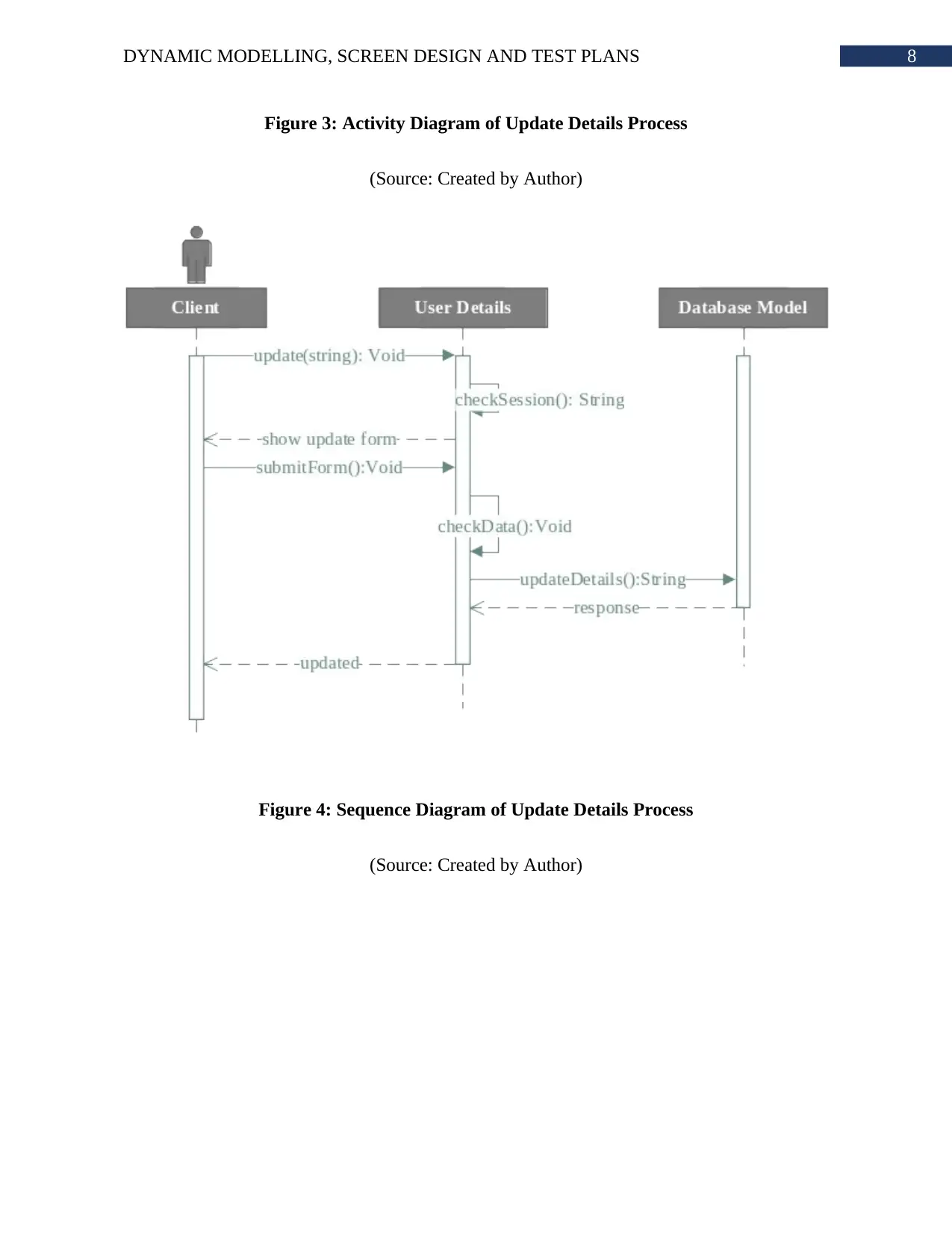
8DYNAMIC MODELLING, SCREEN DESIGN AND TEST PLANS
Figure 3: Activity Diagram of Update Details Process
(Source: Created by Author)
Figure 4: Sequence Diagram of Update Details Process
(Source: Created by Author)
Figure 3: Activity Diagram of Update Details Process
(Source: Created by Author)
Figure 4: Sequence Diagram of Update Details Process
(Source: Created by Author)
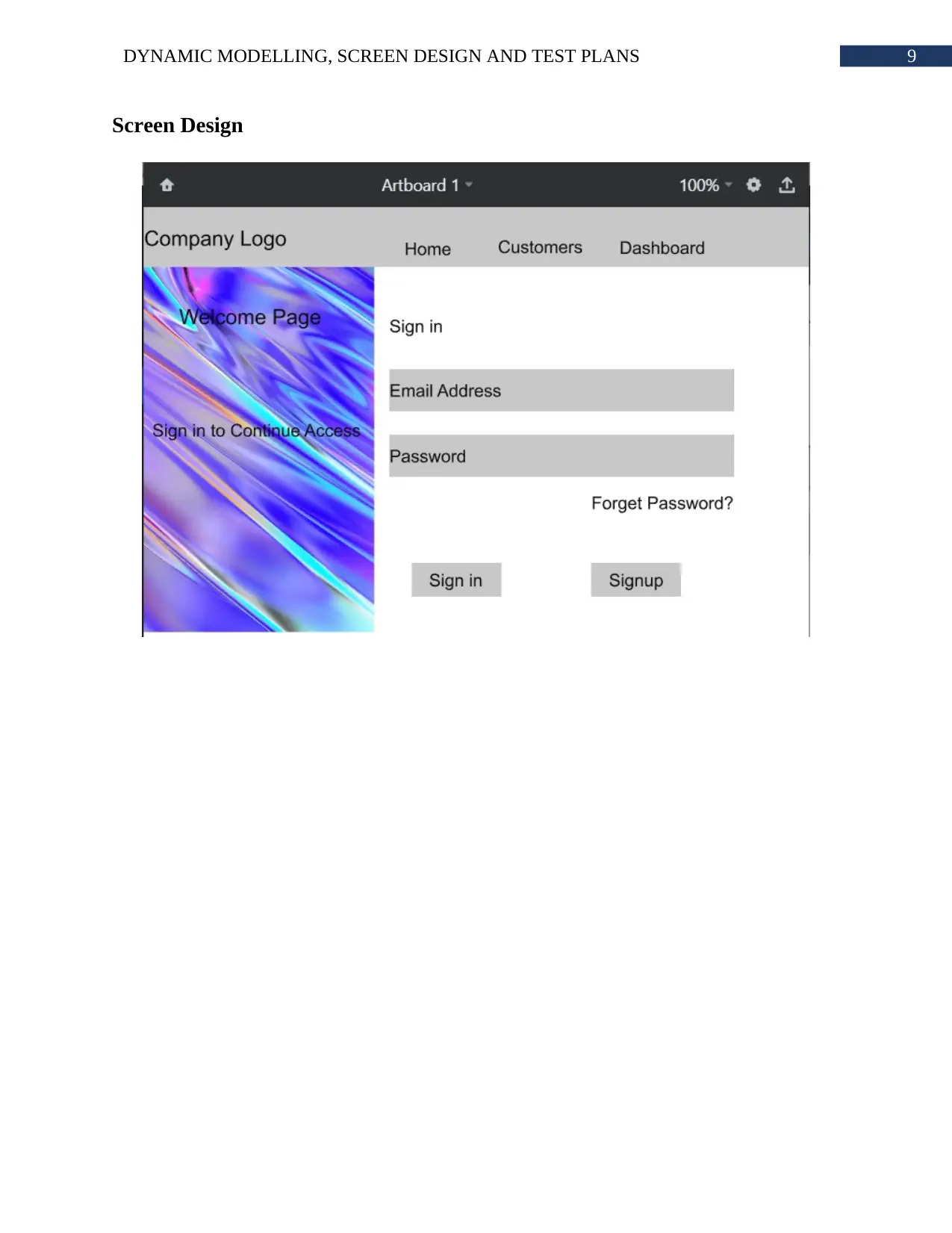
9DYNAMIC MODELLING, SCREEN DESIGN AND TEST PLANS
Screen Design
Screen Design
Secure Best Marks with AI Grader
Need help grading? Try our AI Grader for instant feedback on your assignments.
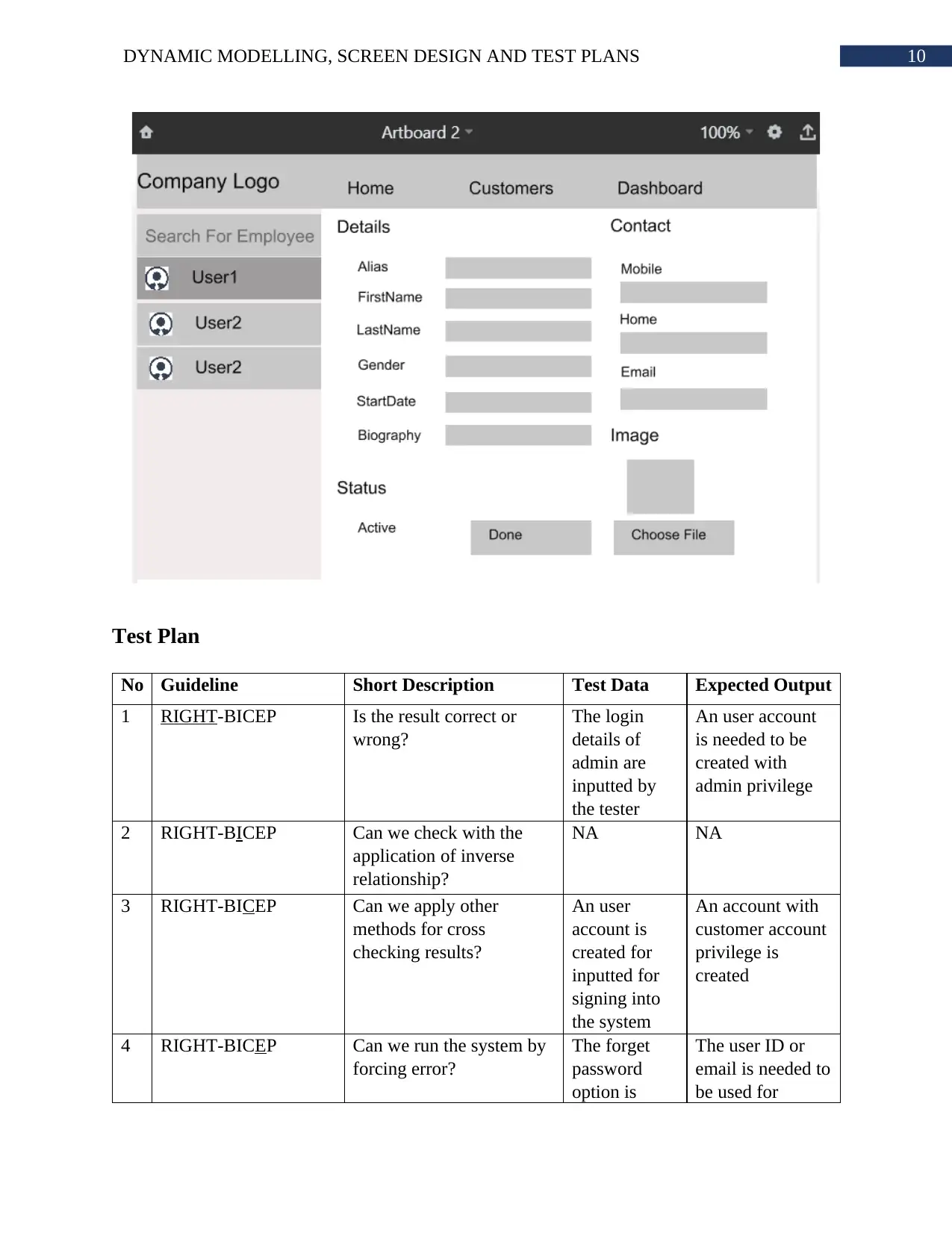
10DYNAMIC MODELLING, SCREEN DESIGN AND TEST PLANS
Test Plan
No Guideline Short Description Test Data Expected Output
1 RIGHT-BICEP Is the result correct or
wrong?
The login
details of
admin are
inputted by
the tester
An user account
is needed to be
created with
admin privilege
2 RIGHT-BICEP Can we check with the
application of inverse
relationship?
NA NA
3 RIGHT-BICEP Can we apply other
methods for cross
checking results?
An user
account is
created for
inputted for
signing into
the system
An account with
customer account
privilege is
created
4 RIGHT-BICEP Can we run the system by
forcing error?
The forget
password
option is
The user ID or
email is needed to
be used for
Test Plan
No Guideline Short Description Test Data Expected Output
1 RIGHT-BICEP Is the result correct or
wrong?
The login
details of
admin are
inputted by
the tester
An user account
is needed to be
created with
admin privilege
2 RIGHT-BICEP Can we check with the
application of inverse
relationship?
NA NA
3 RIGHT-BICEP Can we apply other
methods for cross
checking results?
An user
account is
created for
inputted for
signing into
the system
An account with
customer account
privilege is
created
4 RIGHT-BICEP Can we run the system by
forcing error?
The forget
password
option is
The user ID or
email is needed to
be used for
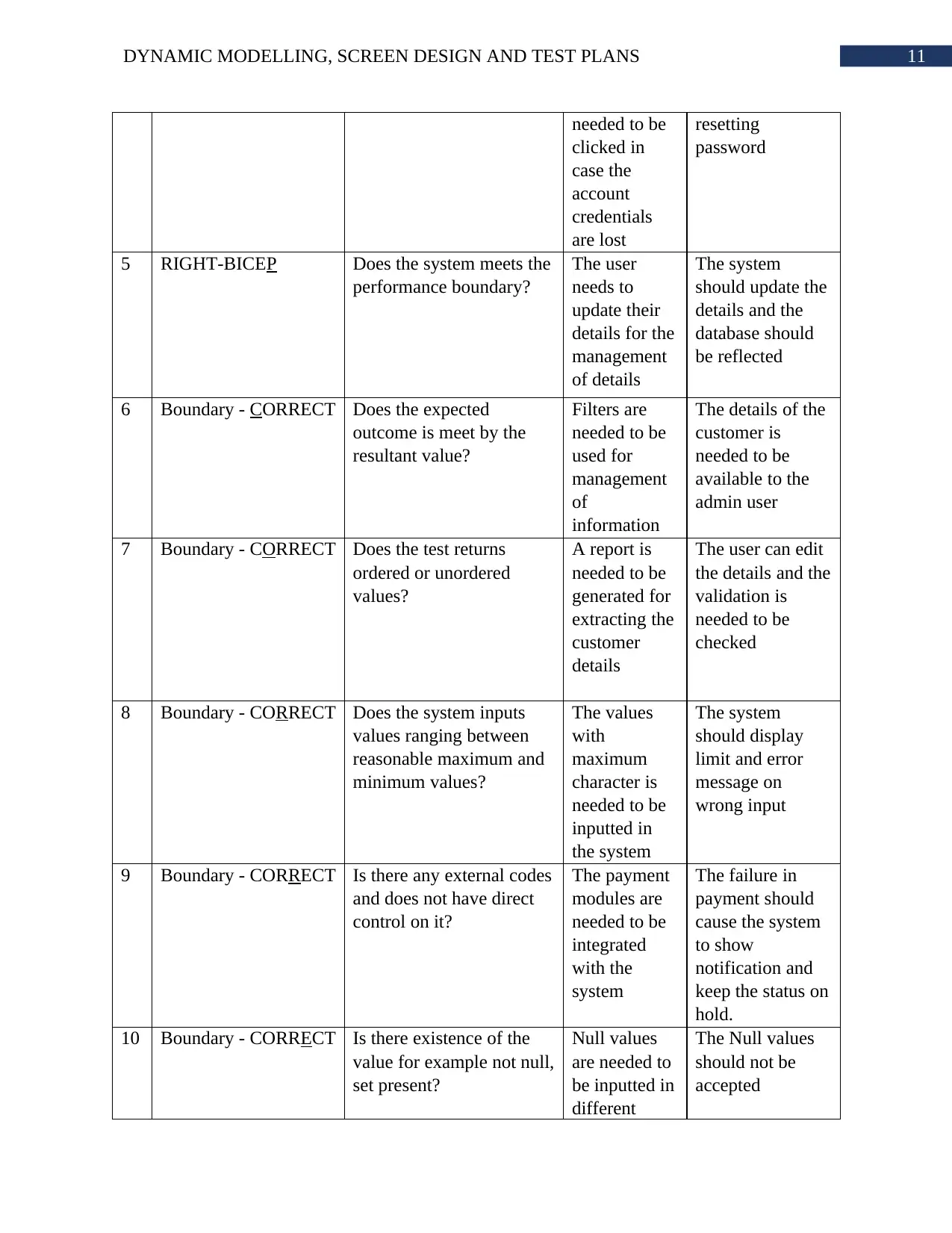
11DYNAMIC MODELLING, SCREEN DESIGN AND TEST PLANS
needed to be
clicked in
case the
account
credentials
are lost
resetting
password
5 RIGHT-BICEP Does the system meets the
performance boundary?
The user
needs to
update their
details for the
management
of details
The system
should update the
details and the
database should
be reflected
6 Boundary - CORRECT Does the expected
outcome is meet by the
resultant value?
Filters are
needed to be
used for
management
of
information
The details of the
customer is
needed to be
available to the
admin user
7 Boundary - CORRECT Does the test returns
ordered or unordered
values?
A report is
needed to be
generated for
extracting the
customer
details
The user can edit
the details and the
validation is
needed to be
checked
8 Boundary - CORRECT Does the system inputs
values ranging between
reasonable maximum and
minimum values?
The values
with
maximum
character is
needed to be
inputted in
the system
The system
should display
limit and error
message on
wrong input
9 Boundary - CORRECT Is there any external codes
and does not have direct
control on it?
The payment
modules are
needed to be
integrated
with the
system
The failure in
payment should
cause the system
to show
notification and
keep the status on
hold.
10 Boundary - CORRECT Is there existence of the
value for example not null,
set present?
Null values
are needed to
be inputted in
different
The Null values
should not be
accepted
needed to be
clicked in
case the
account
credentials
are lost
resetting
password
5 RIGHT-BICEP Does the system meets the
performance boundary?
The user
needs to
update their
details for the
management
of details
The system
should update the
details and the
database should
be reflected
6 Boundary - CORRECT Does the expected
outcome is meet by the
resultant value?
Filters are
needed to be
used for
management
of
information
The details of the
customer is
needed to be
available to the
admin user
7 Boundary - CORRECT Does the test returns
ordered or unordered
values?
A report is
needed to be
generated for
extracting the
customer
details
The user can edit
the details and the
validation is
needed to be
checked
8 Boundary - CORRECT Does the system inputs
values ranging between
reasonable maximum and
minimum values?
The values
with
maximum
character is
needed to be
inputted in
the system
The system
should display
limit and error
message on
wrong input
9 Boundary - CORRECT Is there any external codes
and does not have direct
control on it?
The payment
modules are
needed to be
integrated
with the
system
The failure in
payment should
cause the system
to show
notification and
keep the status on
hold.
10 Boundary - CORRECT Is there existence of the
value for example not null,
set present?
Null values
are needed to
be inputted in
different
The Null values
should not be
accepted
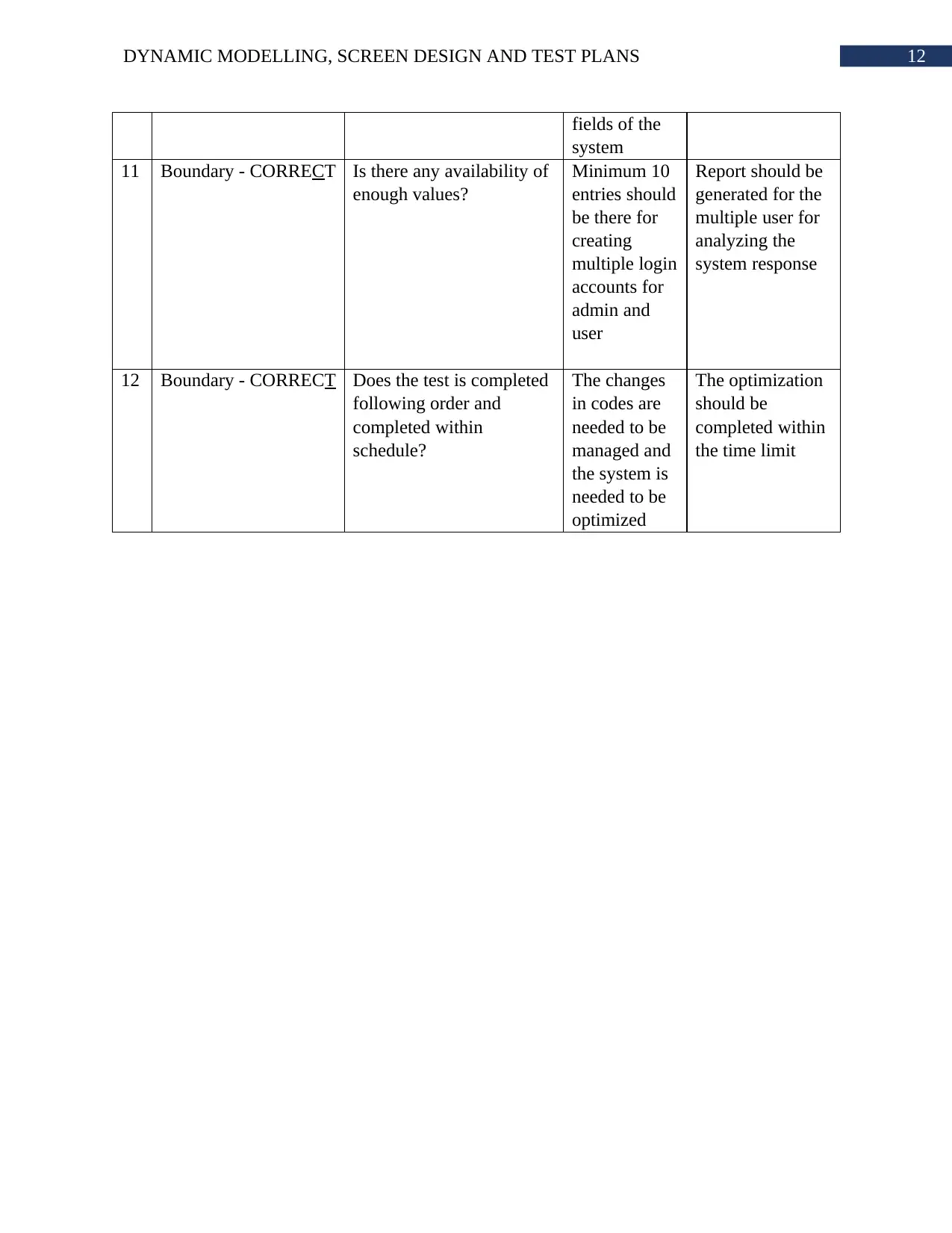
12DYNAMIC MODELLING, SCREEN DESIGN AND TEST PLANS
fields of the
system
11 Boundary - CORRECT Is there any availability of
enough values?
Minimum 10
entries should
be there for
creating
multiple login
accounts for
admin and
user
Report should be
generated for the
multiple user for
analyzing the
system response
12 Boundary - CORRECT Does the test is completed
following order and
completed within
schedule?
The changes
in codes are
needed to be
managed and
the system is
needed to be
optimized
The optimization
should be
completed within
the time limit
fields of the
system
11 Boundary - CORRECT Is there any availability of
enough values?
Minimum 10
entries should
be there for
creating
multiple login
accounts for
admin and
user
Report should be
generated for the
multiple user for
analyzing the
system response
12 Boundary - CORRECT Does the test is completed
following order and
completed within
schedule?
The changes
in codes are
needed to be
managed and
the system is
needed to be
optimized
The optimization
should be
completed within
the time limit
Paraphrase This Document
Need a fresh take? Get an instant paraphrase of this document with our AI Paraphraser
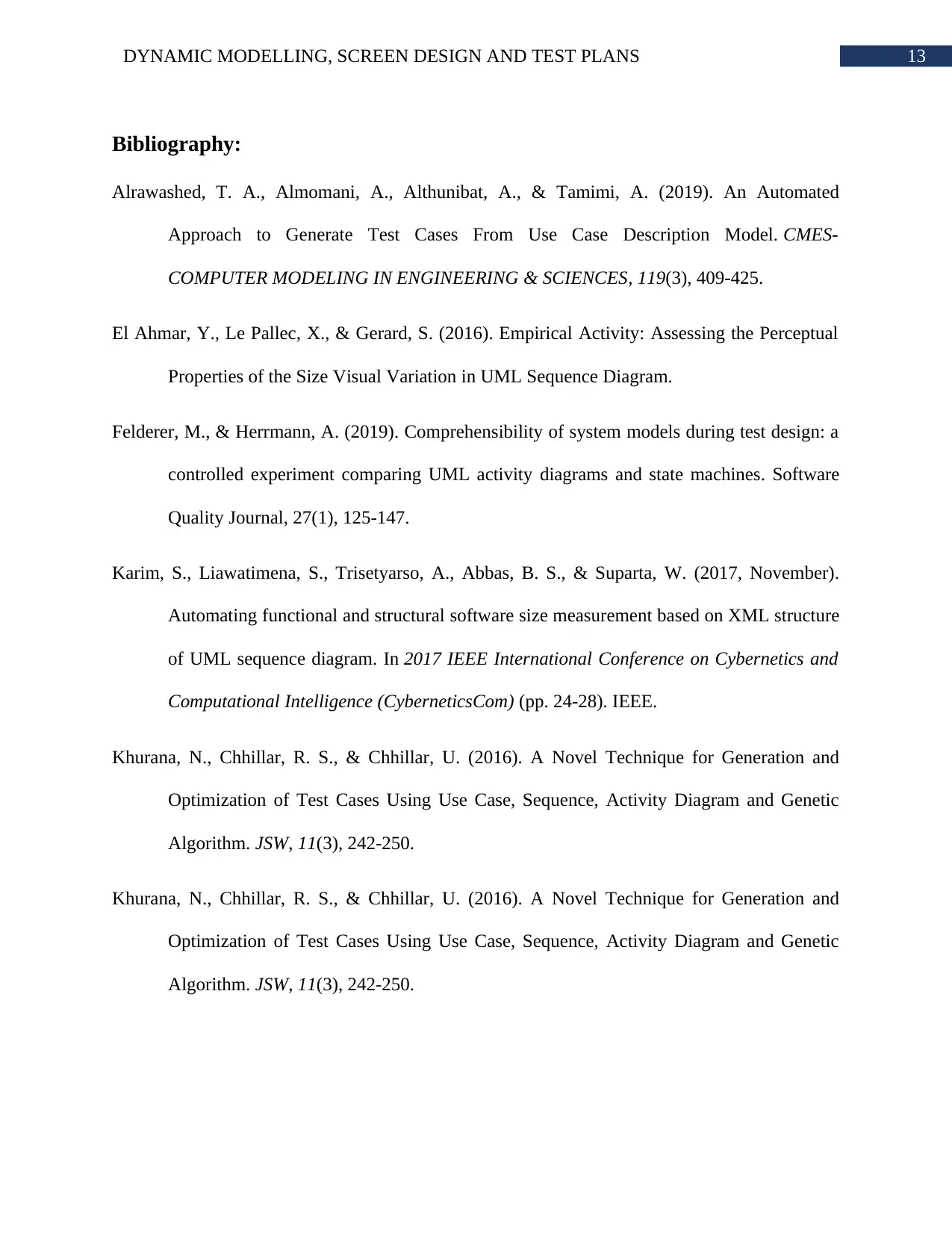
13DYNAMIC MODELLING, SCREEN DESIGN AND TEST PLANS
Bibliography:
Alrawashed, T. A., Almomani, A., Althunibat, A., & Tamimi, A. (2019). An Automated
Approach to Generate Test Cases From Use Case Description Model. CMES-
COMPUTER MODELING IN ENGINEERING & SCIENCES, 119(3), 409-425.
El Ahmar, Y., Le Pallec, X., & Gerard, S. (2016). Empirical Activity: Assessing the Perceptual
Properties of the Size Visual Variation in UML Sequence Diagram.
Felderer, M., & Herrmann, A. (2019). Comprehensibility of system models during test design: a
controlled experiment comparing UML activity diagrams and state machines. Software
Quality Journal, 27(1), 125-147.
Karim, S., Liawatimena, S., Trisetyarso, A., Abbas, B. S., & Suparta, W. (2017, November).
Automating functional and structural software size measurement based on XML structure
of UML sequence diagram. In 2017 IEEE International Conference on Cybernetics and
Computational Intelligence (CyberneticsCom) (pp. 24-28). IEEE.
Khurana, N., Chhillar, R. S., & Chhillar, U. (2016). A Novel Technique for Generation and
Optimization of Test Cases Using Use Case, Sequence, Activity Diagram and Genetic
Algorithm. JSW, 11(3), 242-250.
Khurana, N., Chhillar, R. S., & Chhillar, U. (2016). A Novel Technique for Generation and
Optimization of Test Cases Using Use Case, Sequence, Activity Diagram and Genetic
Algorithm. JSW, 11(3), 242-250.
Bibliography:
Alrawashed, T. A., Almomani, A., Althunibat, A., & Tamimi, A. (2019). An Automated
Approach to Generate Test Cases From Use Case Description Model. CMES-
COMPUTER MODELING IN ENGINEERING & SCIENCES, 119(3), 409-425.
El Ahmar, Y., Le Pallec, X., & Gerard, S. (2016). Empirical Activity: Assessing the Perceptual
Properties of the Size Visual Variation in UML Sequence Diagram.
Felderer, M., & Herrmann, A. (2019). Comprehensibility of system models during test design: a
controlled experiment comparing UML activity diagrams and state machines. Software
Quality Journal, 27(1), 125-147.
Karim, S., Liawatimena, S., Trisetyarso, A., Abbas, B. S., & Suparta, W. (2017, November).
Automating functional and structural software size measurement based on XML structure
of UML sequence diagram. In 2017 IEEE International Conference on Cybernetics and
Computational Intelligence (CyberneticsCom) (pp. 24-28). IEEE.
Khurana, N., Chhillar, R. S., & Chhillar, U. (2016). A Novel Technique for Generation and
Optimization of Test Cases Using Use Case, Sequence, Activity Diagram and Genetic
Algorithm. JSW, 11(3), 242-250.
Khurana, N., Chhillar, R. S., & Chhillar, U. (2016). A Novel Technique for Generation and
Optimization of Test Cases Using Use Case, Sequence, Activity Diagram and Genetic
Algorithm. JSW, 11(3), 242-250.
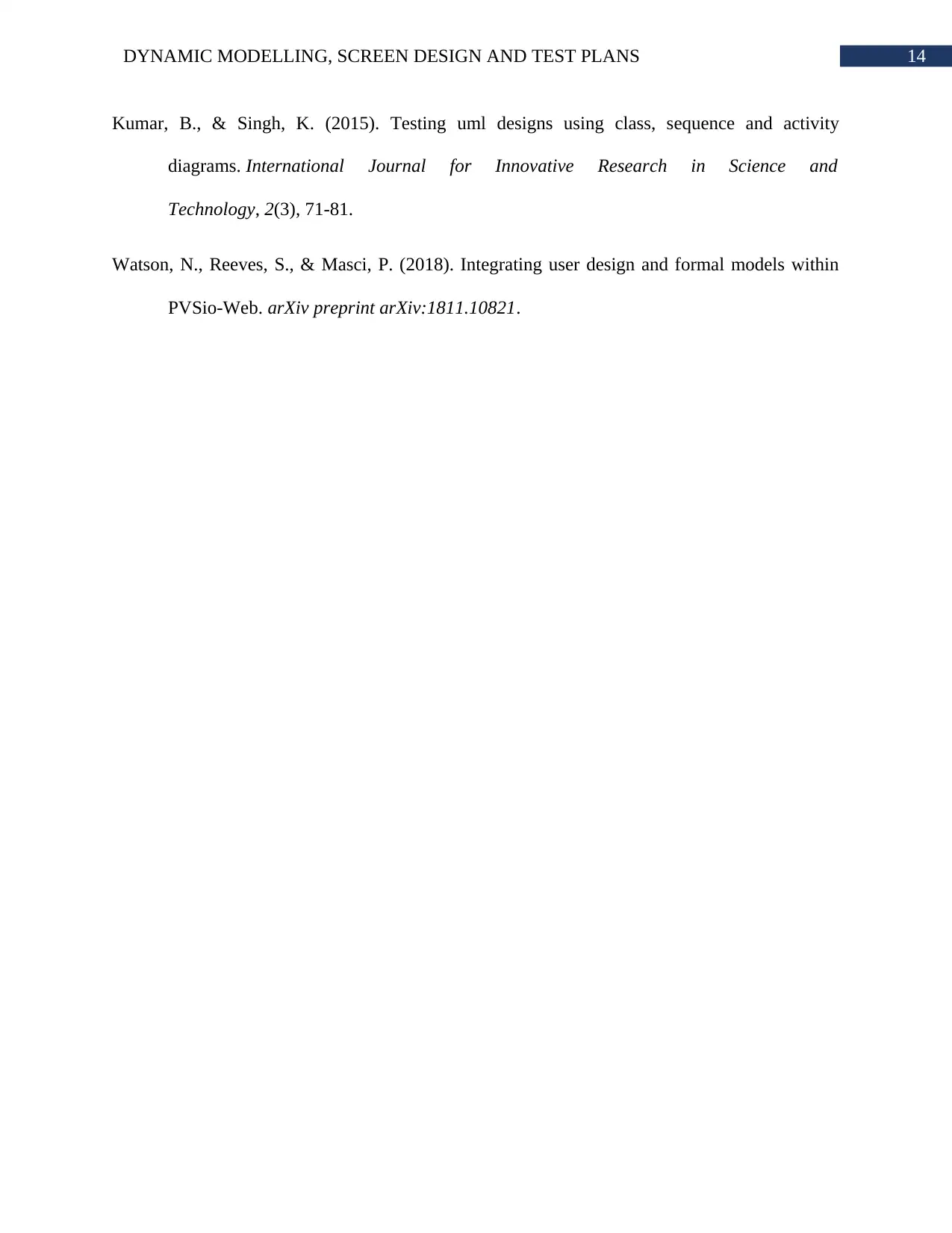
14DYNAMIC MODELLING, SCREEN DESIGN AND TEST PLANS
Kumar, B., & Singh, K. (2015). Testing uml designs using class, sequence and activity
diagrams. International Journal for Innovative Research in Science and
Technology, 2(3), 71-81.
Watson, N., Reeves, S., & Masci, P. (2018). Integrating user design and formal models within
PVSio-Web. arXiv preprint arXiv:1811.10821.
Kumar, B., & Singh, K. (2015). Testing uml designs using class, sequence and activity
diagrams. International Journal for Innovative Research in Science and
Technology, 2(3), 71-81.
Watson, N., Reeves, S., & Masci, P. (2018). Integrating user design and formal models within
PVSio-Web. arXiv preprint arXiv:1811.10821.
1 out of 15
Related Documents
Your All-in-One AI-Powered Toolkit for Academic Success.
+13062052269
info@desklib.com
Available 24*7 on WhatsApp / Email
![[object Object]](/_next/static/media/star-bottom.7253800d.svg)
Unlock your academic potential
© 2024 | Zucol Services PVT LTD | All rights reserved.





